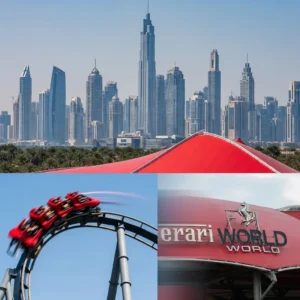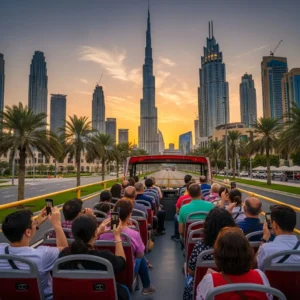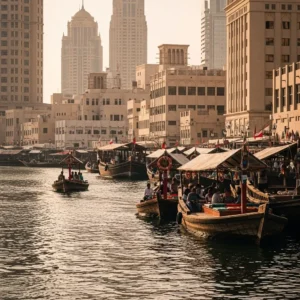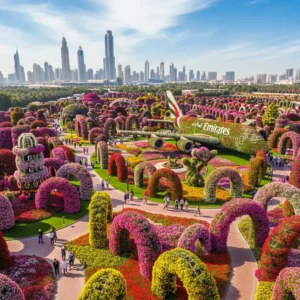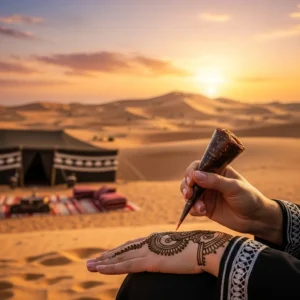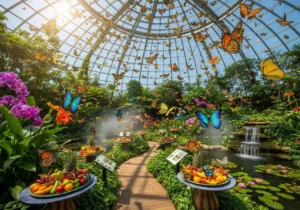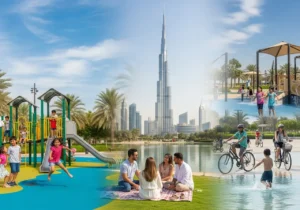A Vision in White: The Complete Visitor’s Guide to Sheikh Zayed Grand Mosque
Standing as a breathtaking monument to faith, art, and unity, the Sheikh Zayed Grand Mosque is the cultural and spiritual heart of Abu Dhabi. This is not merely a building; it is a global landmark, a masterpiece of modern Islamic architecture that leaves every visitor in a state of profound awe. Its brilliant white domes and minarets shimmering under the Arabian sun make it one of the most beautiful places of worship on the planet.
A visit to this architectural wonder is an essential part of any trip to the UAE. It’s an opportunity to witness a level of craftsmanship and artistic devotion that is almost unparalleled in the modern world. The experience is designed to be one of serenity, discovery, and deep cultural immersion, welcoming people from all walks of life to appreciate its splendor.
This comprehensive guide will walk you through every facet of this incredible landmark. From its visionary history and jaw-dropping architectural details to the crucial rules of etiquette you must follow, we will provide everything you need to know to make your visit to the Sheikh Zayed Grand Mosque a respectful, enriching, and truly unforgettable journey.
The Legacy of a Leader: The Vision and History
To understand the soul of the mosque, one must first understand the vision of its founder. The story of its creation is as inspiring as the structure itself.
The Dream of Sheikh Zayed bin Sultan Al Nahyan
The mosque was the long-held dream of the late Sheikh Zayed bin Sultan Al Nahyan, the founding father and first president of the United Arab Emirates. His vision was to create a monumental place of worship that would serve as a beacon of Islamic values like peace, tolerance, and diversity.
He envisioned a structure that would be a masterpiece of Islamic art but also a platform for cross-cultural understanding. He wanted to build a legacy that would be cherished by future generations and admired by the entire world. The Sheikh Zayed Grand Mosque is the magnificent realization of that dream.
A Global Collaboration of Artistry
True to Sheikh Zayed’s vision of unity, the construction of the mosque was a global collaboration of unprecedented scale. The project brought together designers, artisans, and materials from dozens of countries across the globe.
Esteemed architectural firms from the UK and Italy were involved, while materials were sourced from Italy, Germany, Morocco, India, Turkey, Iran, China, and Greece, among others. This international effort is a core part of the mosque’s identity, making it a true fusion of global artistic traditions, all united in a single, harmonious design.
A Symphony in Marble: The Exterior Architecture
The first glimpse of the Sheikh Zayed Grand Mosque is a moment that stays with you forever. Its exterior is a breathtaking study in white and gold, a symphony of classical Islamic architectural forms executed on a colossal scale.
The 82 Domes of Pure White Marble
The most prominent feature of the mosque’s silhouette is its collection of 82 magnificent domes. The largest of these is the main dome over the prayer hall, an engineering marvel in itself. All the domes are clad in pure Sivec marble from Macedonia, chosen for its brilliant, pristine white color that radiates under the sun.
The Four Minarets: A Fusion of Styles
Four towering minarets, each standing at approximately 107 meters (351 feet), anchor the corners of the mosque. They are not uniform in their design. Instead, they cleverly incorporate a fusion of different Islamic architectural styles, including Mamluk, Ottoman, and Fatimid, representing the diversity of the Islamic world.
The Reflective Pools: A Serene Mirror
The mosque is surrounded by a network of beautiful, dark blue tiled reflective pools. These pools serve a dual purpose. They are part of a sophisticated cooling system, but they also create a stunning visual effect. The calm water beautifully mirrors the mosque’s brilliant white columns and domes, creating breathtaking reflections, especially during the serene moments of sunrise and sunset.
The Grand Courtyard (Sahan)
Stepping into the main courtyard, or “sahan,” is a jaw-dropping experience. The sheer scale is immense, capable of holding over 30,000 worshippers. The brilliant white marble floor feels cool underfoot even on warm days.
The World’s Largest Marble Mosaic
The courtyard is home to the world’s largest marble mosaic. This stunning work of art features intricate, flowing floral designs that wind their way across the expansive floor. The vibrant colors of the flowers are not painted; they are created from different types of colored marble and semi-precious stones, painstakingly cut and inlaid by master artisans.
Stepping into Splendor: The Wonders of the Interior
If the exterior of the Sheikh Zayed Grand Mosque is breathtaking, the interior is simply celestial. Every detail is a work of art, designed to inspire a sense of wonder and tranquility.
The Main Prayer Hall: A Space of Awe
The main prayer hall is the heart of the mosque. It is a vast, peaceful space that can accommodate over 7,000 worshippers. The atmosphere inside is one of serene reverence, with the cool marble and quiet ambiance providing a respite from the outside world.
The World’s Largest Hand-Knotted Carpet
Covering the entire floor of the main prayer hall is a true masterpiece: the world’s largest hand-knotted carpet.
The Story of its Creation
This single, seamless carpet was crafted in Iran and is a testament to human dedication. It took approximately 1,200 artisans over two years to complete. The carpet was woven in nine separate pieces and then flown to Abu Dhabi, where it was painstakingly stitched together inside the prayer hall.
The Astounding Statistics
The statistics of the carpet are staggering. It covers over 5,600 square meters, weighs approximately 35 tons, and consists of over 2.2 billion individual knots. Its creation is a story as grand as the Sheikh Zayed Grand Mosque itself.
The Seven Chandeliers of Gold and Crystal
Suspended from the ceilings are seven magnificent chandeliers imported from Germany. They are made from gilded brass and stainless steel and are adorned with millions of sparkling Swarovski crystals.
The Main Chandelier
The largest of these, located under the main dome, is one of the biggest chandeliers in the world. It is 10 meters in diameter, 15 meters high, and weighs approximately 12 tons. It is a dazzling spectacle of light and luxury.
The Columns and Walls: A Floral Tribute
The interior is supported by 96 majestic columns, clustered in groups of four. These columns are clad in marble and inlaid with delicate floral designs using mother of pearl, lapis lazuli, and other semi-precious stones. The floral motifs continue across the walls, creating a sense of a heavenly garden.
The Qibla Wall and the 99 Names of Allah
The Qibla wall, which indicates the direction of Mecca, is another focal point of the main prayer hall. It features the 99 names (qualities) of Allah inscribed in traditional Kufic calligraphy. This calligraphy is subtly illuminated from behind using a delicate fiber-optic lighting system.
The Unique Lighting System
The mosque features a unique lunar illumination system. At night, the exterior of the white domes is lit with a soft, ethereal light that changes according to the phase of the moon. On a full moon, the lighting is bright white, and on other nights, it takes on a soft, cloudy blue hue, creating a magical, ever-changing spectacle. For other tour options, check out https://dubaidesertsafarie.com/.
A Guide to a Respectful Visit: Dress Code and Etiquette
A visit to the Sheikh Zayed Grand Mosque is a privilege, and it requires all visitors to adhere to a strict code of conduct and dress to maintain its sanctity as a place of worship.
The Mandatory Dress Code: A Sign of Respect
The dress code is non-negotiable and strictly enforced at the entrance.
The Dress Code for Women
Women are required to be covered from head to toe. This means wearing a headscarf (shayla) to cover the hair completely, and loose-fitting, non-transparent clothing that covers the arms to the wrist and the legs to the ankle. Tight clothing, such as leggings or tight jeans, and transparent materials are not permitted.
The Dress Code for Men
Men are required to wear long trousers that cover the knees. Shorts of any kind are not allowed. Shirts must have sleeves (t-shirts are acceptable, but vests or sleeveless tops are not).
The Abaya and Shayla Provision
For visitors whose attire does not meet the requirements, the mosque provides traditional clothing free of charge. Women can borrow a clean, hooded robe called an abaya, and men can borrow a traditional robe called a kandura. These must be returned upon exiting.
Rules of Conduct and Etiquette Inside the Mosque
Respectful behavior is expected at all times.
Behavior
Maintain a quiet and respectful demeanor. Running, shouting, and listening to loud music are strictly forbidden.
Physical Contact
Public displays of affection, including holding hands, hugging, or kissing, are not permitted anywhere on the mosque grounds. This rule is strictly enforced by security staff.
Photography Rules
While personal photography is allowed, certain poses are considered disrespectful and are forbidden. These include hand gestures, peace signs, and overly theatrical poses. Security staff may ask you to delete photos if they deem them inappropriate. For other unique adventures, you might consider a desert trip with https://royaldesertadventures.ae/.
Planning Your Visit to the Sheikh Zayed Grand Mosque
A smooth and enjoyable visit requires a bit of planning.
Opening Hours and Best Time to Visit
The mosque is generally open for tourists from 9:00 AM to 10:00 PM from Saturday to Thursday, and from 4:30 PM to 10:00 PM on Fridays. Timings are different during the holy month of Ramadan. The best time to visit is in the late afternoon, about an hour before sunset. This allows you to see the mosque in the beautiful golden hour light and then witness its stunning transformation as it is illuminated at night.
Getting There
The mosque is located at the entrance to Abu Dhabi island. From downtown Abu Dhabi, a taxi is the easiest option. For visitors making a day trip from Dubai, organized tours are a great choice. You can find options at tour providers like https://hafiztourism.com/. Public buses and taxis are also available for the 90-minute journey between the cities.
Tickets and Tours
Entry to the Sheikh Zayed Grand Mosque is completely free. However, all visitors must pre-register online for a timed entry pass. The mosque also offers excellent free guided tours that run throughout the day. These tours are highly recommended as they provide fascinating insights into the architecture, culture, and symbolism of the mosque.
Conclusion
A visit to the Sheikh Zayed Grand Mosque is a profound and deeply moving experience. It is a place where art, culture, and faith converge on a scale that is almost unimaginable. The sheer beauty of the structure, combined with its serene and spiritual atmosphere, leaves a lasting impression on all who enter.
It stands today as a magnificent testament to its founder’s vision of tolerance and unity, and as a timeless masterpiece of Islamic art and architecture. A respectful and awe-filled visit to this incredible landmark is not just a highlight of a trip to Abu Dhabi; it is one of the most remarkable cultural experiences the world has to offer.
Frequently Asked Questions (FAQs)
1. Is there an entrance fee for the Sheikh Zayed Grand Mosque? No, entrance to the Sheikh Zayed Grand Mosque is completely free for all visitors. However, you are required to register online in advance through the official website to get a free timed-entry pass, which helps manage the flow of visitors.
2. How long should I plan for my visit? To fully appreciate the mosque without feeling rushed, you should allocate at least 90 minutes to 2 hours for your visit. If you plan on taking one of the free guided tours, which are highly recommended and last about 45-60 minutes, you should plan for a total visit of around 2 to 2.5 hours.
3. What happens if my clothes are not considered appropriate? The mosque has a very efficient system for visitors whose attire does not meet the strict dress code. At the visitor center, you will be directed to a dedicated area where you can borrow traditional clothing free of charge. Women are provided with a clean abaya (a long robe with a hood), and men can borrow a kandura (a white robe) if needed.
4. Can non-Muslims enter the main prayer hall? Yes, the Sheikh Zayed Grand Mosque warmly welcomes visitors of all faiths. Non-Muslims are allowed to enter the main prayer hall as part of the designated visitor route. However, certain areas may be roped off to preserve the sanctity of the prayer space. You are not allowed to enter during prayer times.
5. Are there guided tours available, and are they free? Yes, the mosque offers excellent complimentary guided tours that are a highlight of any visit. These are led by official cultural guides who provide fascinating insights into the architecture, art, and Islamic culture. The tours run regularly throughout the day, and you do not need to book them in advance; simply join the next available tour when you arrive.
6. Is there a specific time for the lunar illumination at night? The exterior lighting of the mosque begins after sunset each day. The unique lunar illumination system, which projects soft, cloud-like lights onto the white domes, is designed to change with the phases of the moon. The lighting is a continuous display throughout the evening until the mosque closes.
7. Can I take a taxi from Dubai directly to the mosque? Yes, taking a taxi or a ride-hailing service like Uber or Careem from Dubai to the mosque is a very convenient and popular option. The journey takes approximately 90 minutes, depending on traffic. While it is more expensive than the bus, it offers door-to-door service.
8. Are there cafes or restaurants at the mosque? Yes, the visitor center, known as Souk Al Jami’, has a large food court with a variety of international fast-food and casual dining options. There are also several cafes, including one where you can get the famous “Palace Cappuccino” with gold flakes. You are not allowed to bring food or drink into the mosque itself.
9. Is the mosque wheelchair accessible? Yes, the Sheikh Zayed Grand Mosque is fully accessible for wheelchair users and people with limited mobility. There are ramps and elevators throughout the complex. The mosque also provides wheelchairs for visitors who may require them.
10. What are the rules for photography inside the mosque? Personal photography with phones and small cameras is permitted and encouraged. However, certain poses, such as hand gestures or overly dramatic poses, are considered disrespectful and are not allowed. It is also forbidden to photograph other people without their permission. The use of professional cameras and tripods may require a special permit.
11. Do I have to take my shoes off to enter the mosque? Yes, as is customary in all mosques, you will be required to remove your shoes before entering the main prayer hall. There are designated shoe racks available where you can safely store your footwear while you explore the interior.
12. Can I visit the mosque during prayer times? The mosque is temporarily closed to tourists for short periods during the five daily prayer times to allow worshippers to pray without disturbance. On Fridays, the mosque is closed to tourists until 4:30 PM for the main congregational prayer. It is always best to check the daily prayer times before your visit to plan accordingly.
13. Are men and women separated during the visit? Men and women go through separate security and dress code checks upon entry. However, once inside the main visitor areas, such as the courtyard and the designated path through the prayer hall, families and groups can walk together. Certain areas, like the ablution facilities, are segregated.
14. What is the best way to get from the mosque to other Abu Dhabi attractions? Taxis are readily available at the dedicated taxi stand at the visitor center. This is the easiest and most convenient way to travel from the Sheikh Zayed Grand Mosque to other key attractions in the city like the Louvre Abu Dhabi or Qasr Al Watan.
15. Is there anything else to see at the mosque complex? Yes, the visitor center, Souk Al Jami’, is a destination in itself. It is a beautifully designed, air-conditioned underground souk that connects the entrance to the mosque. It features a range of shops selling high-quality souvenirs, perfumes, and handicrafts, as well as the food court and cafes.
